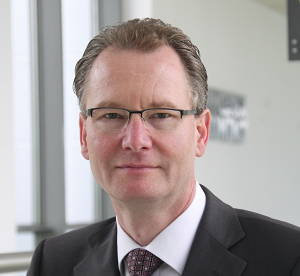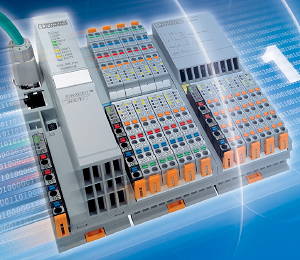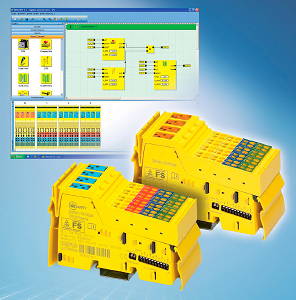`World’s fastest` I/O system is as simple as terminal block
![]() Phoenix Contact has unveiled a real-time I/O system which, it claims, is the world’s fastest. The system, called Axioline, has been designed to be as fast, robust and simple to use as a terminal block. The company’s executive vice-president Roland Bent describes the system as “a revolutionary leap that makes a real, application-independent, real-time I/O possible”.
Phoenix Contact has unveiled a real-time I/O system which, it claims, is the world’s fastest. The system, called Axioline, has been designed to be as fast, robust and simple to use as a terminal block. The company’s executive vice-president Roland Bent describes the system as “a revolutionary leap that makes a real, application-independent, real-time I/O possible”.
Speaking at the recent SPS/IPC/Drives show in Germany where the system made its debut, Bent (below) said that the company had gone back to the fundamental principles of I/O systems to develop the system. “After the paradigm shift in communication technology caused by Ethernet and other similar innovations, the time has come for a new, revolutionary approach to serial I/O systems,” Bent declared. “The time has come for a system that is as fast and as simple as the terminal block.”

The central premise behind the development of Axioline was to create a system that always functions in real-time, regardless of the application. It also had to respond as quickly as direct cabling – or, at least, close enough to parallel cabling – to make the differences in transfer rates irrelevant.
The system achieves an update time of 500ns–1µs for every terminal block, depending on the I/O configuration. This corresponds to the time taken for an electrical signal to travel along around 100m of cable. For a 256 I/O system, the update time is less than 6µs, which is comparable to the time taken for a signal to pass along 1km of parallel cabling.
“Time is no longer an issue for the user of an Axioline system,” Bent contends, adding that the system “surpasses all of the limits of existing systems and achieves transfer rates of less than 10µs – a figure that was previously only attained by parallel cabling. We call this real-time I/O.”

Mechanically, the snap-fit I/O modules – which Phoenix calls terminal blocks – can be assembled without tools and can be exchanged at any time. The wiring is installed using pluggable terminals that give the user the option to exchange an entire block or just the I/O.
Field connections are made using the same push-in technology as Phoenix’s Clipline Complete terminal block system. Rigid conductors and conductors with ferrules can be inserted directly, without tools. For slim, flexible cables, the terminals can be opened using a screwdriver. I/O power is supplied via a terminal in each block, making time-consuming calculations of load combinations unnecessary.
The 50mm-high terminal blocks are mechanically compatible with modular terminal blocks and are suitable for standard control cabinets with flat widths of 80mm. The blocks are available in widths of 18, 32 or 54mm, with the widest versions supporting up to 64 terminal points. This allows 16 digital I/O to be connected using a four-conductor technology, or 64 digital inputs using a single-conductor technology. Smaller terminal blocks, down to single I/Os, are in the pipeline, as is software for configuring I/O signals.
The Axioline system is designed to meet EMC requirements without needing any additional protection such as shielded connection boxes. Shock and vibration resistance are identical to those of a terminal block, and the system can handle continuous shock levels of at least 10g. The operating temperature range is -25°C to +60°C.
At the SPS/IPC/Drives show, Phoenix was showing some initial components for the Axioline system, including terminal blocks and bus couplers. The system bus is similar to a Fast Ethernet system, making it suitable for providing I/O for Ethernet systems. The first bus couplers are designed for Profinet (RT and IRT) and Sercos III and will thus support many current motion control applications. Other couplers are planned.
The system’s architecture makes future developments possible in a variety of directions. One possibility is to couple the Axioline backplane bus directly to high-speed PC-based controls such as Phoenix’s new soft-PLC. In future, Axioline processor platforms could operate as integrated, decentralised high-speed controllers.
New functions for configuring I/Os and signals and providing safety features are also being developed. The architecture allows the system to develop in the direction of process engineering functions such as hot-swapping.
♦ The Axioline system was one of several innovations unveiled by Phoenix Contact at the SPS/IPC/Drive show. Another was a device, called SafetyBridge (shown below), that spans the gap between parameterisable safety controllers and safety bus systems with their own safety controllers. Up to five input and output modules can communicate safely with a parameterised output module using any bus or wireless transmission system.

According to Roland Bent, Phoenix has continued to invest in innovation despite the economic downturn which has slashed the group’s turnover by around 21% during 2009, taking it below €1bn, compared to €1.18bn in 2008. “This crisis has not brought innovation to a standstill,” he said at the SPS/IPC/Drives show. “Now is the time to create a new foundation for future growth using radical innovations.”
Bent described 2009 as “one of the most challenging years in the recent history of Phoenix Contact,” with significant drops in turnover and orders across the world, except for China, where the group has continued to grow. Although Phoenix has introduced cost-cutting measures and short-time working, it has so far avoided staff layoffs. The company has made “a clear commitment to maintain this as a priority in the future,” says Bent. Phoenix is retraining its permanent staff “so that the company is fully prepared for the resurgence of the economy – which is not far off, in our view,” he adds. “It is quite possible that we will achieve moderate, single-figure growth next year.”





